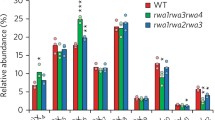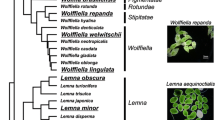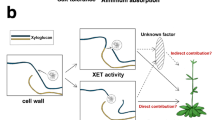Abstract
Main conclusion
Xylans in the cell walls of monocots are structurally diverse. Arabinofuranose-containing glucuronoxylans are characteristic of commelinids. However, other structural features are not correlated with the major transitions in monocot evolution.
Most studies of xylan structure in monocot cell walls have emphasized members of the Poaceae (grasses). Thus, there is a paucity of information regarding xylan structure in other commelinid and in non-commelinid monocot walls. Here, we describe the major structural features of the xylans produced by plants selected from ten of the twelve monocot orders. Glucuronoxylans comparable to eudicot secondary wall glucuronoxylans are abundant in non-commelinid walls. However, the α-d-glucuronic acid/4-O-methyl-α-d-glucuronic acid is often substituted at O-2 by an α-l-arabinopyranose residue in Alismatales and Asparagales glucuronoxylans. Glucuronoarabinoxylans were the only xylans detected in the cell walls of five different members of the Poaceae family (grasses). By contrast, both glucuronoxylan and glucuronoarabinoxylan are formed by the Zingiberales and Commelinales (commelinids). At least one species of each monocot order, including the Poales, forms xylan with the reducing end sequence -4)-β-d-Xylp-(1,3)-α-l-Rhap-(1,2)-α-d-GalpA-(1,4)-d-Xyl first identified in eudicot and gymnosperm glucuronoxylans. This sequence was not discernible in the arabinopyranose-containing glucuronoxylans of the Alismatales and Asparagales or the glucuronoarabinoxylans of the Poaceae. Rather, our data provide additional evidence that in Poaceae glucuronoarabinoxylan, the reducing end xylose residue is often substituted at O-2 with 4-O-methyl glucuronic acid or at O-3 with arabinofuranose. The variations in xylan structure and their implications for the evolution and biosynthesis of monocot cell walls are discussed.








Similar content being viewed by others

Abbreviations
- AGX:
-
Arabinoglucuronoxylan
- AIR:
-
Alcohol-insoluble residue
- Araf :
-
Arabinofuranose
- Arap :
-
Arabinopyranose
- 2AB:
-
2-Aminobenzamide
- GlcpA:
-
Glucuronic acid
- MeGlcpA:
-
4-O-Methyl glucuronic acid
- 13C NMR:
-
Carbon nuclear magnetic resonance spectroscopy
- GAX:
-
Glucuronoarabinoxylan
- GX:
-
Glucuronoxylan
- 1H NMR:
-
Proton nuclear magnetic resonance spectroscopy
- MALDI-TOF:
-
MS matrix-assisted laser desorption time-of-flight mass spectrometry
- Xylp :
-
Xylopyranose
References
Bacic A, Harris P, Stone B (1988) Structure and function of plant cell walls. In: Preiss J (ed) The biochemistry of plants. Academic Press, San Diego, pp 297–371
Bigge J, Patel T, Bruce J, Goulding P, Charles S, Parekh R (1995) Nonselective and efficient fluorescent labeling of glycans using 2-amino benzamide and anthranilic acid. Anal Biochem 230:229–238
Bremer B, Bremer K, Chase M, Fay M, Reveal J, Soltis D, Soltis P, Stevens P (2009) An update of the Angiosperm Phylogeny Group classification for the orders and families of flowering plants: APG III. Bot J Linnean Soc 161:105–121
Buanafina M (2009) Feruloylation in grasses: current and future perspectives. Mol Plant 2:861–872
Carnachan SM, Harris PJ (2000) Polysaccharide compositions of primary cell walls of the palms Phoenix canariensis and Rhopalostylis sapida. Plant Physiol Biochem 38:699–708
Carpita NC (1996) Structure and biogenesis of the cell walls of grasses. Annu Rev Plant Biol 47:445–476
Carpita NC, Gibeaut DM (1993) Structural models of primary cell walls in flowering plants: consistency of molecular structure with the physical properties of the walls during growth. Plant J 3:1–30
Chase M, Soltis DE, Olmstead RG, Morgan D, Les D, Mishler BD, Duvall MR, Price RA, Hills HG, Qiu Y-L (1993) Phylogenetics of seed plants: an analysis of nucleotide sequences from the plastid gene rbcL. Ann Mo Bot Garden 80:528–580
Chase M, Fay MF, Devey DS, Maurin O, Rønsted N, Davies TJ, Pillon Y, Petersen G, Seberg O, Tamura M (2006) Multigene analyses of monocot relationships: a summary. Aliso 22:63–75
Chong S-L, Koutaniemi S, Juvonen M, Derba-Maceluch M, Mellerowicz EJ, Tenkanen M (2015) Glucuronic acid in Arabidopsis thaliana xylans carries a novel pentose substituent. Int J Biol Macromol 79:807–812
Darvill JE, McNeil M, Darvill AG, Albersheim P (1980) Structure of plant cell walls: XI. Glucuronoarabinoxylan, a second hemicellulose in the primary cell walls of suspension-cultured sycamore cells. Plant Physiol 66:1135–1141
Domon B, Costello C (1988) A systematic nomenclature for carbohydrate fragmentations in FAB-MS/MS spectra of glycoconjugates. Glycoconjug J 5:397–409
Ebringerova A, Hromadkova Z, Heinze T (2005) Hemicellulose. Adv Polym Sci 186:1–67
Fangel J, Ulvskov P, Knox JP, Mikklelsen M, Harholt J, Popper Z, Willats W (2012) Cell wall evolution and diversity. Front Plant Sci 3:1–8
Gibeaut DM, Pauly M, Bacic A, Fincher GB (2005) Changes in cell wall polysaccharides in developing barley (Hordeum vulgare) coleoptiles. Planta 221:729–738
Givnish TJ, Ames M, McNeal J, McKain MR, Steele PR, dePamphilis CW, Graham SW, Pires JC, Stevenson D, Zomlefer W (2010) Assembling the tree of the monocotyledons: plastome sequence phylogeny and evolution of Poales. Ann Mo Bot Garden 97:584–616
Glushka JN, Terrell M, York WS, O’Neill MA, Gucwa A, Darvill AG, Albersheim P, Prestegard JH (2003) Primary structure of the 2-O-methyl-α-fucose-containing side chain of the pectic polysaccharide, rhamnogalacturonan II. Carbohydr Res 338:341–352
Harris P (2006) Primary and secondary plant cell walls: a comparative overview. N Zeal J For Sci 36:36–53
Harris PJ, Hartley R (1980) Phenolic constituents of the cell walls of monocotyledons. Biochem Syst Ecol 8:153–160
Harris PJ, Trethewey J (2010) The distribution of ester-linked ferulic acid in the cell walls of angiosperms. Phytochem Rev 9:19–33
Harris PJ, Kelderman MR, Kendon MF, McKenzie RJ (1997) Monosaccharide compositions of unlignified cell walls of monocotyledons in relation to the occurrence of wall-bound ferulic acid. Biochem Syst Ecol 25:167–179
Hervé C, Rogowski A, Gilbert HJ, Knox JP (2009) Enzymatic treatments reveal differential capacities for xylan recognition and degradation in primary and secondary plant cell walls. Plant J 58:413–422
Hsieh YSY, Harris PJ (2009) Xyloglucans of monocotyledons have diverse structures. Mol Plant 2:943–965
Ishii T, Konishi T, Ono H, Ohnishi-Kameyama M, Togashi H, Shimizu K (2008) Assignment of the 1H and 13C NMR spectra of 2-aminobenzamide-labeled xylo-oligosaccharides. Carbohydr Polym 74:579–589
Johansson M, Samuelson O (1977) Reducing end groups in brich xylan and their alkaline degradation. Wood Sci Technol 11:251–263
Kulkarni AR, Pattathil S, Hahn M, York W, O’Neill MA (2012a) Comparison of arabinoxylan structure in bioenergy and model grasses. Ind Biotechnol 8:222–229
Kulkarni AR, Peña MJ, Avci U, Mazumder K, Urbanowicz B, Pattathil S, Yin Y, O’Neill MA, Roberts AW, Hahn MG (2012b) The ability of land plants to synthesize glucuronoxylans predates the evolution of tracheophytes. Glycobiology 22:439–451
Lampugnani E, Moller I, Cassin A, Jones D, Koh PL, Ratnayake S, Beahan C, Wilson SM, Bacic A, Newbigin E (2013) In vitro grown pollen tubes of Nicotiana alata actively synthesise a fucosylated xyloglucan. PLoS One 8:e77140
Landolt E (1986) Biosystematic investigation in the family of duckweeds (“Lemnaceae”). The family of “Lemnaceae”: a monographic study, vol 2. Veröffentlichungen des Geobotanischen Institutes der ETH, Zürich
Liu L, Paulitz J, Pauly M (2015) The presence of fucogalactoxyloglucan and its synthesis in rice indicates conserved functional importance in plants. Plant Physiol 168:549–560
Mazumder K, York W (2010) Structural analysis of arabinoxylans isolated from ball milled switchgrass biomass. Carbohydr Res 345:2183–2193
Mortimer JC, Faria-Blanc N, Yu X, Tryfona T, Sorieul M, Ng YZ, Zhang Z, Stott K, Anders N, Dupree P (2015) An unusual xylan in Arabidopsis primary cell walls is synthesised by GUX3, IRX9L, IRX10L and IRX14. Plant J 83:413–426
Packer NH, Lawson MA, Jardine DR, Redmond JW (1998) A general approach to desalting oligosaccharides released from glycoproteins. Glycoconjug J 15:737–747
Peña MJ, Zhong R, Zhou GK, Richardson EA, O’Neill MA, Darvill AG, York WS, Ye ZH (2007) Arabidopsis irregular xylem8 and irregular xylem9: implications for the complexity of glucuronoxylan biosynthesis. Plant Cell 19:549–563
Peña MJ, Darvill AG, Eberhard S, York WS, O’Neill MA (2008) Moss and liverwort xyloglucans contain galacturonic acid and are structurally distinct from the xyloglucans synthesized by hornworts and vascular plants. Glycobiology 18:891–899
Peña MJ, Kong Y, York WS, O’Neill MA (2012) A galacturonic acid-containing xyloglucan is involved in Arabidopsis root hair tip growth. Plant Cell 24:4511–4524
Ratnayake S, Beahan CT, Callahan DL, Bacic A (2014) The reducing end sequence of wheat endosperm cell wall arabinoxylans. Carbohydr Res 386:23–32
Reis A, Pinto P, Evtuguin D, Neto CP, Domingues P, Ferrer-Correia A, Domingues MRM (2005) Electrospray tandem mass spectrometry of underivatised acetylated xylo-oligosaccharides. Rapid Comm Mass Spectrom 19:3589–3599
Saulnier L, Vigouroux J, Thibault J-F (1995) Isolation and partial characterization of feruloylated oligosaccharides from maize bran. Carbohydr Res 272:241–253
Shatalov AA, Evtuguin DV, Pascoal Neto C (1999) (2-O-α-d-Galactopyranosyl-4-O-methyl-α-d-glucurono)-d-xylan from Eucalyptus globulus Labill. Carbohydr Res 320:93–99
Smith SA, Donoghue MJ (2008) Rates of molecular evolution are linked to life history in flowering plants. Science 322:86–89
Smith B, Harris P (1999) The polysaccharide composition of Poales cell walls: Poaceae cell walls are not unique. Biochem Syst Ecol 27:33–53
Togashi H, Kato A, Shimizu K (2009) Enzymatically derived aldouronic acids from Eucalyptus globulus glucuronoxylan. Carbohydr Polym 78:247–252
Urbanowicz BR, Peña MJ, Ratnaparkhe S, Avci U, Backe J, Steet HF, Foston M, Li H, O’Neill MA, Ragauskas AJ, Darvill AG, Wyman C, Gilbert HJ, York WS (2012) 4-O-methylation of glucuronic acid in Arabidopsis glucuronoxylan is catalyzed by a domain of unknown function family 579 protein. Proc Nat Acad Sci USA 109:14253–14258
York WS, O’Neill MA (2008) Biochemical control of xylan biosynthesis—which end is up? Curr Opin Plant Biol 11:258–265
Zablackis E, Huang J, Muller B, Darvill AG, Albersheim P (1995) Characterization of the cell-wall polysaccharides of Arabidopsis thaliana leaves. Plant Physiol 107:1129–1138
Zhong R, Teng Q, Lee C, Ye Z-H (2014) Identification of a disaccharide side chain 2-O-α-d-galactopyranosyl-α-d-glucuronic acid in Arabidopsis xylan. Plant Signal Behav 9:e27933
Acknowledgments
This research was funded by the BioEnergy Science Center (BESC). BESC is a U.S. Department of Energy Bioenergy Research Center supported by the Office of Biological and Environmental Research in the DOE Office of Science. We also acknowledge the U.S. Department of Energy-funded Center for Plant and Microbial Complex Carbohydrates (Grant DE-FG02-93ER20097) for equipment support.
Author information
Authors and Affiliations
Corresponding author
Ethics declarations
Conflict of interest
The authors declare that they have no conflict of interest
Additional information
M. J. Peña and A. R. Kulkarni contributed equally to this study.
Electronic supplementary material
Below is the link to the electronic supplementary material.
Rights and permissions
About this article
Cite this article
Peña, M.J., Kulkarni, A.R., Backe, J. et al. Structural diversity of xylans in the cell walls of monocots. Planta 244, 589–606 (2016). https://doi.org/10.1007/s00425-016-2527-1
Received:
Accepted:
Published:
Issue Date:
DOI: https://doi.org/10.1007/s00425-016-2527-1



